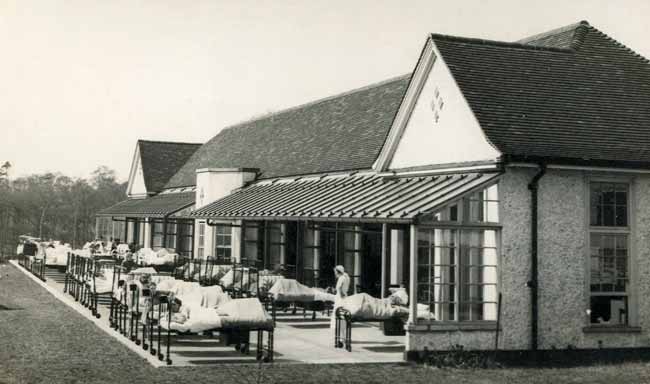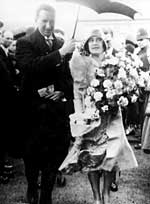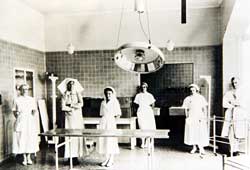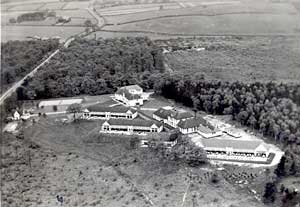
Harlow Wood: Orthopaedic hospital

Harlow Wood in the 1920s (Photo courtesy of Pauline Marples).
At the end of the nineteenth century Nottingham was one of many towns which suffered from poverty, poor hygiene and many crippling diseases; tuberculosis, rickets, poliomyelitis which flourished in the poor conditions. It was against this background that the plight of crippled children and the prospect of their effective treatment which led public spirited individuals to find a way to treat them.
As a result in 1907 the Nottingham Cripples Guild was founded. The Annual reports of the Guild give an insight into the problem faced by the sufferers and their families. For many children who suffered from physical disabilities the problems were impacted by the difficulty of movement and were unable to gain from an education. In later life this lack of education made it impossible for them to find employment and many were forced to ‘solicit alms in order to obtain the necessaries of life’.
Alderman J A H Green, the then Mayor of Nottingham, had shown a keen interest in forming the Cripple’s Guild was elected the first President, but when he became Town Clerk, he had to step down and Winifred, Her Grace the Duchess of Portland accepted the role. She carried out a lot of work for the Guild and other Nottinghamshire charities. She took office in 1908 and it was only with her death in 1954 that the position became vacant. All officers were long-serving which helped to continue the good work of the Guild.
In the first year of its inception, 1908, there were 490 children registered as crippled; each one was visited by a member of the Visiting Committee who reported on their well-being. Outings were arranged and the Automobile Club provided the transport; a private convalescent home was established at Gringley on the Hill by the Duke of Portland and Captain Laycock; help was provided in both education and also in the use of surgical appliances – both usage and keeping them in good repair.
In 1912 the Guild was amalgamated with the Invalid Children’s Aid Society. The city was divided into districts and visitors reported weekly on the case load. The following year, 1913 the case was made for the provision of a hospital to treat the cripples. Many, up to 95%, were thought to be capable of a being completely cured if they had long periods of rest, unfortunately normal hospitals were unable to provide this service.
At the end of the First World War, a plan was put forward for the erection of an orthopaedic hospital but it was five years later before Sir Robert Jones, the doyen of orthopaedic surgery, was invited by the Duchess of Portland to Nottingham to discuss the orthopaedic problem in the City. Jones and G R Girdlestone had established a National Scheme for the Prevention and cure of crippled children and with this in mind he was asked to make recommendations for an Orthopaedic centre in Nottingham. One of his recommendations was the employment of a full time orthopaedic surgeon and that he should confine himself to the practice of orthopaedic surgery only. Another recommendation was that the Cripple’s Guild, together with other local bodies begin a scheme to provide for the cripples of Nottingham.
Alan Malkin was appointed Orthopaedic Surgeon in 1923 and had a substantial background in orthopaedics as well as being recommended by Sir Robert Jones. The Guild went ahead with plans for a clinic, rather than a hospital to alleviate the burden on the Nottingham General Hospital. Treatment such as ultra-violet light, massage and exercise were offered and in 1921 Miss Margaret Wright, who had skill and training in these treatments was appointed as masseuse on a part-time basis. Later an Orthopaedic Sister was appointed.
The clinic moved from St James’s Street to a larger premises at 45 Park Row, premises that were donated by Sir Jesse Boot. Eventually land was leased by the City Corporation on Park Row for the construction of a specifically designed building; with a plaster room, a gymnasium and treatment rooms for boys and girls. In 1926 the average number of attendances each week was 274. In 1927 whilst on a visit to Nottingham, Princess Mary was shown around the Clinic. In 1928 a Foot Clinic within the main clinic was established and treatment carried out by two voluntary chiropodists. Other neighbouring towns were setting up their own clinics; Hucknall particularly benefited from the generosity of Sir Julien Cahn who built and equipped a clinic at his own expense in 1927.
Nevertheless, a specific orthopaedic hospital was always the final goal; Sir Robert Jones had the idea that a country house could be made into an orthopaedic hospital; however many of the houses which comprised the Dukeries were still occupied and Clumber had been burned down in 1879. There had been talk of using Bulwell Hall previously but this fell through. Discussions kept the idea alive and finally with the gift of a piece of land in Harlow Wood by the Duke of Portland in 1927 allowed the dream to become a reality.

The Duchess of York at Harlow Wood in 1929 (Photo courtesy of Pauline Marples).
The Appeal launched a huge interest with donations from rich and poor alike. There were fetes and galas, a Society Ball and an attempt to lay a mile of pennies around the streets of Nottingham – unfortunately this was broken up because of ‘exigencies of traffic’! However over £109 was raised through this method. A considerable sum in those days. By the summer of 1928 only half of the required money had been raised but it was decided to go ahead and start the project, by building one ward and part of the nurse’s home and administration block. The project was obviously viewed as an important piece of social work as Sir Jesse Boot offered his workmen – who were in the process of finishing the University College project at Highfields – to work on the hospital for free giving a saving of 10%. He also made generous donations towards the cost of the buildings. The Foundation Stone was laid on 7 November 1928 by the Duchess of Portland. The hard work of the ‘free’ workmen and the enthusiasm of the Duchess drove the construction on at a pace and the building was officially opened on 3 August 1929 by the Duchess of York (later the Queen Mother).
In the beginning two wards had been built one for boys and one for girls with 40 beds in each; plus provision for some adults bringing the total bed space to 86. The wards faced due south in front of which was a wide open veranda on which the beds could be placed and only in severe weather were the glazed folding doors closed! Housed within the administration block was the operating theatre, a plaster room and a gym. Other buildings on the site were garage for an ambulance, Nurse’s Home and a house for the porter. At the first Annual General Meeting in 1930 there was some concern about how much was stilled owing on the building which had cost £42,700; more than originally planned. However, money was found, again thanks to the efforts of the Duchess.

The theatre at Harlow Wood in the 1930s (Photo courtesy of Pauline Marples).
Costing for a third ward was begun in 1932 and work began in January 1933. A considerable sum was donated from the Ollerton Miners’ Sick and Accident Fund and the Nottingham Miner’s Welfare Committee, which allowed the 40 bed ward to be completed in and opened in August 1933. Although today we would consider the conditions Spartan, the hospital was at the forefront of orthopaedic work. By 1939 the hospital was ‘complete’ and now had four wards with accommodation for 155 patients and 67 resident staff. From the opening of the hospital through until 1939 the hospital was visited by many dignitaries including King George VI, the then Princess Royal, Alice, Edward VIII, the Prince of Wales, Feb 1933, Sir Stanley and Lady Baldwin in 1931 and members of the England and Australian Cricket teams in June 1934. For many patients, mainly children, they spent long periods of time at the hospital, far greater than they would today, and a school was provided to help keep up their education, despite having to do classes in frames, lying on their backs or on plaster beds.

Harlow Wood from the air in the 1930s (Photo courtesy of Pauline Marples).
Not long after the declaration of war on 3rd September 1939, the hospital was transformed and ready for war in a short space of time. Walls and verandas were painted green and tape was attached to glass windows to avoid injury from shattering glass. The hospital, as with other hospitals was taken over by the Emergency Medical Service. Several new wards were constructed, albeit in huts, and the staff increased, to cope with the increase in patients, mainly from wounded soldiers. One development which burgeoned from this time was that of physiotherapy taking over from massage.
At the end of the war, the hospital was returned to normality, with sandbags and green paint removed. New wards were built with an Occupational Therapy department and an Appliance workshop. In order to promote rapid recovery, a Gymnasium and a remedial pool were opened. The pool was the brain child of Alan Malkin who suggested a static water tank which was not being used could be utilised and once again Queen Elizabeth opened the pool as well as the Portland Training College in July 1950. The introduction of the National Health Service in 1948 caused a few concerns but these proved unfounded. With a gradual improvement in living conditions the devastating illnesses such as tuberculosis, rickets and poliomyelitis became less of a problem than they had been at the beginning of the century. However, work at the hospital continued with much use of the out-patients clinic with patients coming from a wide area including parts of Lincolnshire and Derbyshire as well as Nottinghamshire.
Great improvements were made in orthopaedic treatment, including osteoarthritis of the hip and the knee, arthroscopy, rheumatoid arthritis and leg length inequality. Backache was something which the hospital had less success with and it was when Robert Mulholland took an interest that a greater understanding of the underlying causes of back-pain and its management was developed.
The hospital became renowned the world over and was the venue for numerous European Conferences on Orthopaedics in the 1970s and 1980s. It was at the frontier of orthopaedic medicine, research and the development of new techniques under the guidance of eminent doctors in their field; one of many was Angus Wallace, who later moved to the University Hospital and is remembered for his ‘operation’ on a passenger on flight from the Far East who had collapsed. The hospital celebrated its Diamond jubilee in May 1989 and was visited by the then Duchess of York, Sarah Ferguson.
Two institutions were established within the grounds of Harlow Wood, the wood rather than the hospital grounds but were not hospitals: the Portland Training College for the Disabled, a vocational training centre and rehabilitation centre, opened in 1950 and Thieves’ Wood School for Severely Handicapped Children opened in 1957 now renamed Fountingdale School, the principle aim of the school was to develop severely disabled youngsters to their full potential, mentally, physically and socially.
In the 1970s, plans for a new Medical school were underway, which would have significant impact on the orthopaedic treatment in Nottinghamshire. The University Hospital was opened by the Queen in July 1977. In 1978 two orthopaedic wards were opened at the hospital and over time the number of beds available increased to 126, rising to 144 in 1985.